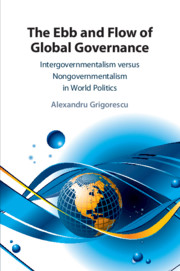 The Ebb and Flow of Global Governance
The Ebb and Flow of Global Governance Published online by Cambridge University Press: 17 March 2020
The empirical chapters had two primary purposes. First, they offered support for this book’s main argument: that individual global governors, as well as the aggregate global governance in specific issue-areas, are better understood as falling along an intergovernmental–nongovernmental continuum rather than simply into one of two dichotomous categories. By focusing on this continuum, we can observe the many subtle changes that take place in the intergovernmental or nongovernmental character of global governance. Second, the chapters assessed the plausibility of the two main explanations for global governance shifts across the intergovernmental–nongovernmental continuum.
To save this book to your Kindle, first ensure [email protected] is added to your Approved Personal Document E-mail List under your Personal Document Settings on the Manage Your Content and Devices page of your Amazon account. Then enter the ‘name’ part of your Kindle email address below. Find out more about saving to your Kindle.
Note you can select to save to either the @free.kindle.com or @kindle.com variations. ‘@free.kindle.com’ emails are free but can only be saved to your device when it is connected to wi-fi. ‘@kindle.com’ emails can be delivered even when you are not connected to wi-fi, but note that service fees apply.
Find out more about the Kindle Personal Document Service.
To save content items to your account, please confirm that you agree to abide by our usage policies. If this is the first time you use this feature, you will be asked to authorise Cambridge Core to connect with your account. Find out more about saving content to Dropbox.
To save content items to your account, please confirm that you agree to abide by our usage policies. If this is the first time you use this feature, you will be asked to authorise Cambridge Core to connect with your account. Find out more about saving content to Google Drive.